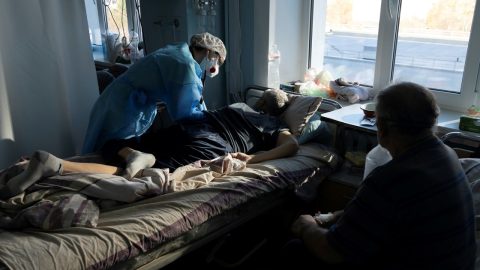
After decades of good news in the fight against cervical cancer — marked by decades of steady declines in cases and deaths — a new report suggests that some women are being left behind.
Thanks to early detection and treatment, rates of cervical cancer have plummeted by more than half over the past 50 years. Rates are falling fastest among women in their early 20s, the first generation to benefit from HPV vaccines, which were approved in 2006.
HPV, the human papillomavirus, causes six types of cancer, including cervical cancer.
Among women aged 20 to 24, cervical cancer incidence dropped by 65% from 2012 to 2019, according to a report released Wednesday from the American Cancer Society.
“Cervical cancer is one of the best-understood cancers,” said Dr. Nicolas Wentzensen, a senior investigator in the National Cancer Institute’s clinical genetics branch, who was not involved in the new report. “We’ve made amazing progress and it remains a success story.”
Not all women are benefitting from that progress, however.
The overall cervical cancer rate among women of all ages has stopped falling.
Too old for HPV vaccination?
Among women in their 30s and early 40s, incidence has been edging upward. Diagnosis of cervical cancer among women ages 30 to 44 rose almost 2% a year from 2012 to 2019.
“We need to make sure we are not forgetting about that generation that was a little too old for HPV vaccination,” said Jennifer Spencer, an assistant professor at the Dell Medical School at University of Texas-Austin who studies population health.
Fortunately, the cancers found in 30- and 40-something women were mostly early, curable tumors, said Ahmedin Jemal, senior author of the new report and the cancer society’s senior vice president for surveillance and health equity science. About 13,800 American women are diagnosed with cervical cancer each year and 4,360 die from the disease.
Researchers didn’t delve into the reasons why cervical cancer is becoming more common for some women, Jemal said.
But screening rates may play a role, said Spencer, who was not involved in the study. Screenings allow doctors to find and remove precancerous lesions before they become cancerous. More than half of women diagnosed with cervical cancer have either never been screened or haven’t been screened in the past five years, according to the Centers for Disease Control and Prevention.
Studies show that fewer women are keeping up with routine cervical cancer exams.
The number of women ages 21 to 65 who have been screened according to the latest guidelines fell from 87% in 2000 to 72%, according to the National Cancer Institute.
Other research has found that women ages 21 to 29 were the least likely to be up to date on their screenings, with 29% being overdue. Women were also more likely to be behind schedule if they were nonwhite, uninsured, lived in rural areas or identified as gay, lesbian or bisexual, according to the study.
The U.S. Preventive Services Task Force recommends screening women ages 21-29 with Pap smears — which examine cells under a microscope — every three years. Women ages 30 to 65 can be screened either every three years with a Pap smear or every five years with an HPV test or combination of the two tests. HPV tests can detect genetic material from the human papilloma virus.
Spencer said it’s possible that low screening rates among 20-something women could help explain the slightly higher cervical cancer rates among women in their 30s and early 40s.
When women in one of Spencer’s studies were asked why they hadn’t been screened recently, they commonly said that they didn’t know they needed to be screened or that a health provider hadn’t recommended it. Only 1% women ages 21 to 29 said they had skipped screening because they had received the HPV shot.
“Clearly, more patient education is needed,” said Dr. Betty Suh-Burgmann, chair of gynecologic oncology for Kaiser Permanente Northern California. Her health care system already reminds women about screenings by postcards, letters and phone calls. This year, Kaiser Permanente will begin texting patients, as well, she said.
Changing guidelines about cervical cancer screening also may have left women and health providers confused, Spencer said. Until the early 2000s, most doctors screened women annually. The task force has updated its guidelines three times in the past two decades, and is in the process of reviewing them again.
Others say the increase in cervical cancer rates among 30- and 40-something women isn’t so easily explained.
Cervical tumors tend to grow slowly, typically taking a decade or more to morph from precancers to cancers, Wentzensen said. He said there may be other factors at play. For example, he wonders if more women moving to the United States haven’t been screened, putting them at higher risk.
And Spencer notes that screening is just the first step to saving lives. Women with abnormal screening results need to undergo additional testing and, if necessary, treatment.
In a study published last year in the American Journal of Preventive Medicine, Spencer and her colleagues found that only 73% of women with abnormal screening results received follow-up care.
“The onus is on the health care system to think about who is slipping through the cracks,” Spencer said.










Recent Comments